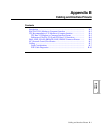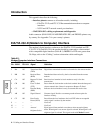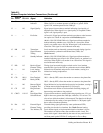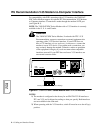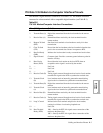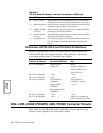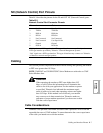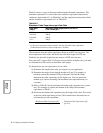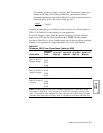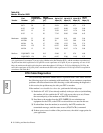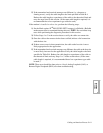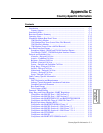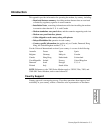
B-8 Cabling and Interface Pinouts
Interface
Pinouts
Table B-4 shows a range of data rates and maximum allowable capacitances. The
maximum capacitance is a total of the inter-conductor capacitance (between the
conductors represented as Cc in Table B-4), and the capacitance between the shield
and the conductor (represented as Cs in Table B-4).
The maximum allowable cable capacitance decreases as DTE rates increase. The
more capacitance in the cable, the shorter the allowable length at a DTE rate.
Similarly, the allowable lengths become shorter as DTE rates increase.
Since newer PCs support EIA 232-D type receivers/drivers at higher rates, you must
use information in this section to determine cable length.
To determine the per foot capacitance of your cable:
1) Determine the length of the cable you require for your application.
2) Determine the range of rates that the modem will use. (For example, to
routinely operate the modem's DTE port between 20.0 and 96.0 kbps,
determine the cable capacitance for the higher rate. You can operate the
modem up to, but not exceeding, the maximum rate capacitance that you
calculate.)
3) Refer to Table B-4 for the maximum allowable cable capacitance for a given
rate. (For example, to operate the modem at 64.0 kbps, the maximum
capacitance is 900 pF.)
4) Divide the maximum cable capacitance by the length of the cable. This results
in the total cable capacitance per foot. The formula below illustrates how to
calculate the per-foot capacitance:
Table B-4.
Maximum Cable Capacitance per Data Rate
Data Rate
(kbps)
Maximum Cable Capacitance (Cc+Cs) in
Pico Farads (pF)*
0-20.0 2400 pF
20.0-64.0 900 pF
64.0-96.0 400 pF
115.2 200 pF
Notes:
*(1) The total capacitance in this column is the total allowable cable capacitance.
(2) Maximum resistance of cable conductors is 25 Ohms.
Maximum Cable Capacitance (pF)
Total Cable Length in Feet
=
Maximum Cable Capacitance (pF)
per Foot




